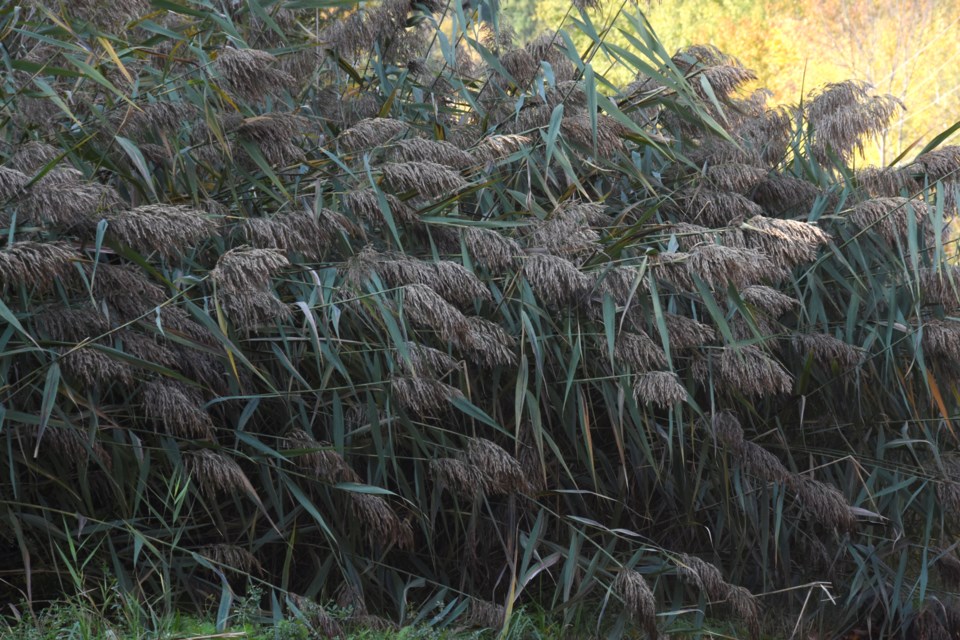Now that the gypsy moth caterpillars are cocooning and no longer bombarding your patio with their poop, you may be at a loss as to what to worry about next. Not a problem. Always something of concern “out there.” This week it’s all about phragmites!
This tall (very tall) plant has been showing up with an alarmingly rapid rate of density and spread in local ditches, shorelines and wetlands, and is a cause of financial concern to municipalities. (See, as soon as I mentioned spending taxpayers’ money, you kept reading. If I had just said that this plant is crowding out native vegetation, you may have jumped over to the comics page or went straight to the obituaries.)
So, yes, this plant is a financial burden due to its ability to block waterways (ditches and drains), interfere with the majestic view of the water from your lakeside home (decreased property values), or possibly spread fire from your backyard drain to the backyard porch (safety concerns). An estimated $3 million is spent annually in Ontario on controlling phragmites, so you might as well learn a bit about why this is so.
Just to be clear what it is we are talking about, phragmites is that super tall grass-like plant that has a large broom-like seed head. Started out as an exotic addition to landscape projects but has ‘jumped the fence’ and is now found everywhere from the shores of our lakes to the median strips of our highways.
‘Phragm’ means divider or fence and ‘ites’ means pertaining to; gotta love the Greek language, so descriptive and to the point. Thick bands of phragmites do indeed create a fence of sorts and can be just as effective as chain-link when it comes to interfering with wildlife travel. Those of us involved with this plant usually refer to it just as ‘phrag.’
As with most invasive species, phragmites reproduces rapidly and has no natural controls. (Hey, maybe we can convince gypsy moths to eat phrag?) It loves open, sandy, sunny, wet spots, which sure sounds like the description of your favourite beach.
While the negative impacts to our natural environment can be readily noted, from massive displacement of a wide diversity of native vegetation to the interference of turtle egg-laying and songbird nesting, it is the insidious altering of water and nutrient cycling that really makes this the bad boy of invasives.
Phragmites is tall, has a hollow stem and large leaves, all of which makes water transpiration easy and copious. Shallow wetlands have been dried out by having phrag literally suck the water away and release it as water vapour.
Phrag stems are woody and take a long time to decompose, unlike cattail leaves. A cattail takes up nutrients and then releases them again during the winter as the leaves rot; phrag holds all their nutrients in those stick-like stems for years.
I mentioned fire earlier. These dead stems are excellent kindling, being held high and dry after death, and being tightly spaced, hollow stemmed and wood-like. There are recent incidents of phragmites patches catching fire (both accidental and deliberate) and roaring out of control along beach areas and within those backyard drainage ditches found in housing subdivisions. Firefighters don’t come cheaply.
Interestingly, this plant has been used by different cultures over the millennia, the leaves woven as roof thatch, the stems bound as floor mats and musical instruments created by boring holes and making flutes. Unfortunately, these uses are no longer hot items at the local home-building store.
So, how hard can it be to wipe out this scourge? The answer is very, and is both time consuming and costly. To thwart phrag growth you have to cut off seed dispersal, remove underground root growth (called rhizomes) and eliminate above-ground creeping stems (called stolens). This is not a one-shot Saturday-morning fix-it project with a handful of volunteers.
Not to diminish the need for enthusiastic volunteers, but the bigger scope of the project will require city staff (both administratively and field crews), tools from shovel and clippers to backhoes and dump trucks, permissions from provincial and local authorities, as well as licensed and trained herbicide applicators. Now you can see where the money starts adding up.
Good news is that some organizations and municipalities are teaming up to map the locations of phrag, determine worst-case scenarios (both environmentally and municipally), create management plans (easier to hit several individual small patches than wait for it to become a giant connected mass of continuous vegetation) and, wait for it, actually doing something.
To control phragmites an array of techniques has to be applied, from cutting and collecting seed heads to cutting stolens and digging up rhizomes. Chemical applications of glyphosate are the most effective but require extreme care in application. Flooding and drowning freshly cut stems can work but water control is rarely available.
Locally, I am aware of a few projects happening this summer to combat phragmites: the City of Orillia is working with Lakehead University to try sample removals using a variety of non-chemical techniques; Tiny Township and Ducks Unlimited (Canada) are financially supporting the Marl-Tiny-Matchedash Conservation Association with mapping and removals at Tiny Marsh and Matchedash Bay.
For oodles more information, I recommend you go to the Ontario Invasive Plant Council website. Prepare for information overload but it’s all good stuff.
There are many more projects underway as phragmites has established itself across the province. While my personal concern is about habitat disruption, there are many municipal councillors out there who are realizing a new line has to be added to the operating budget.
